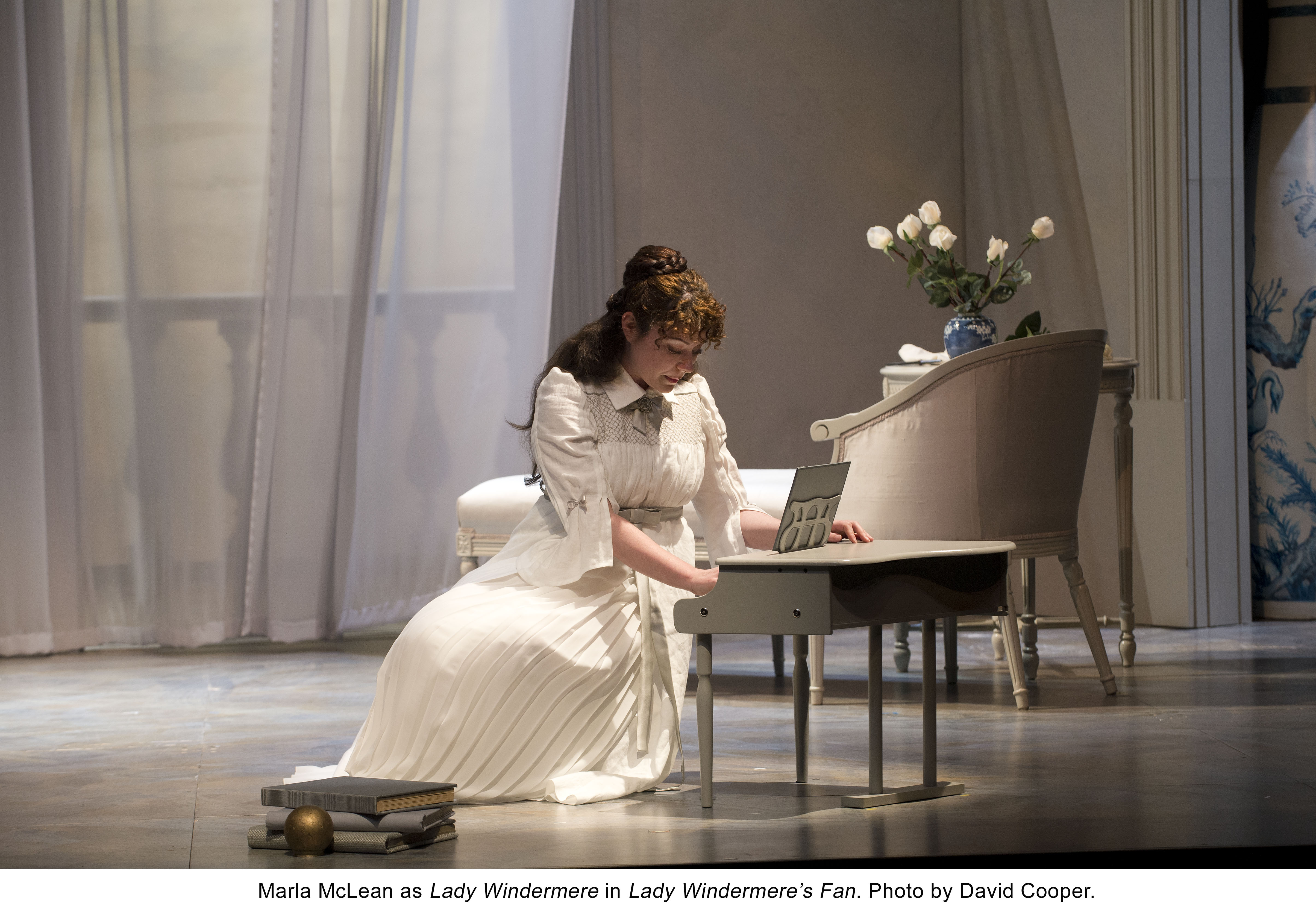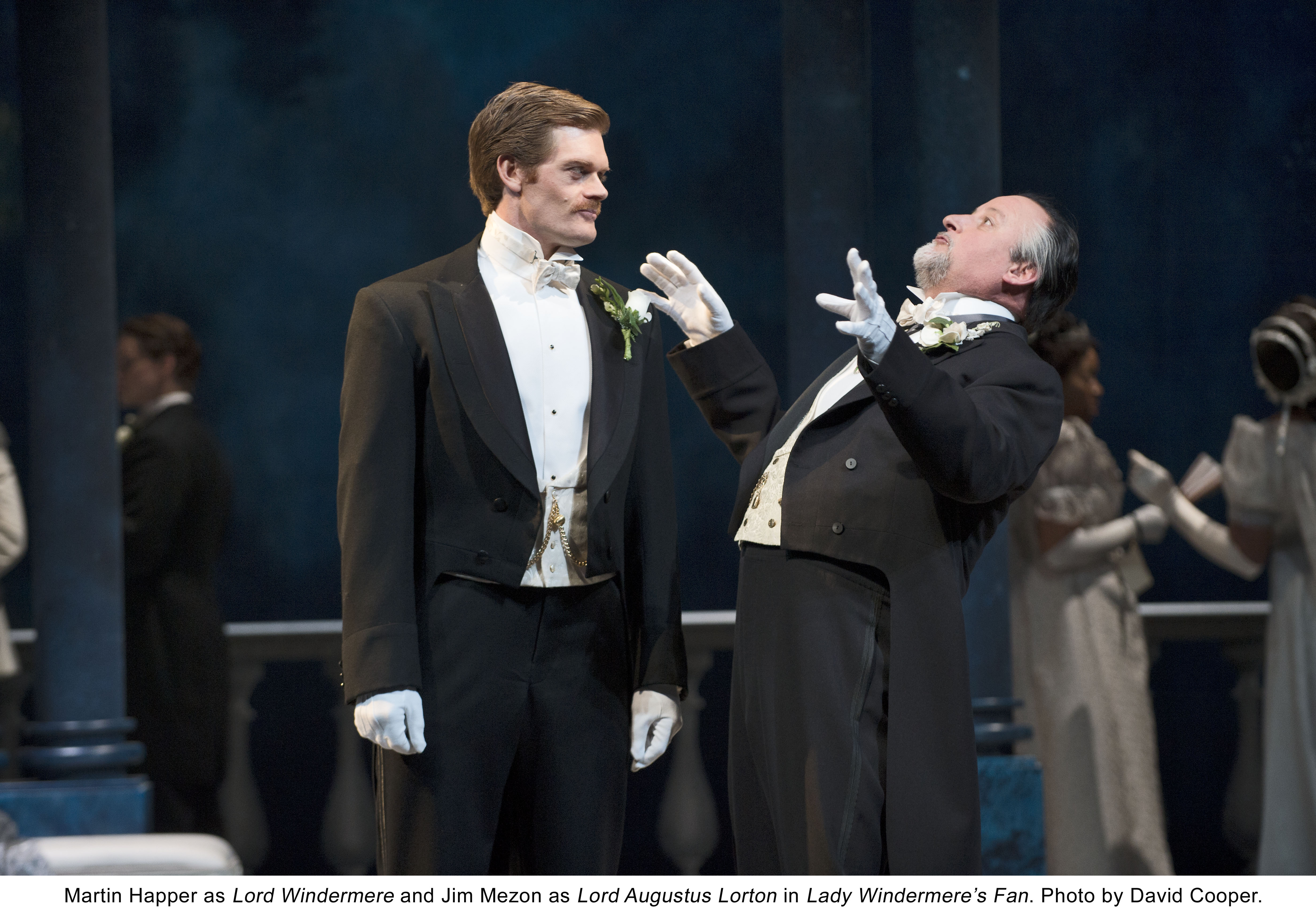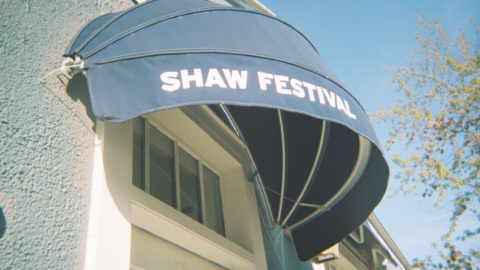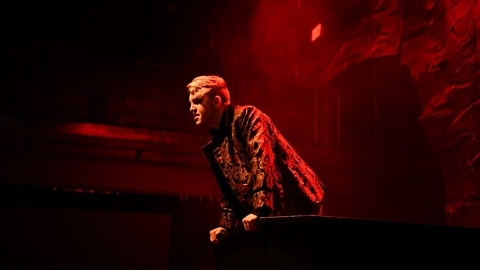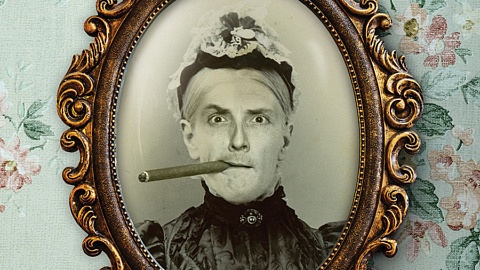Hello theatre creators, educators, scholars and everything in between! I hope you’re having a productive-yet-restful summer. Ever wonder what it’s like...
The reviews are in! Lady Windermere’s Fan
The 35 students in DART’s Theatre Criticism class saw the Shaw Festival’s production of Lady Windermere’s Fan on 24 October, 2013. Here is a selection of the DARTcritics’ reviews.
Hayley Malouin writes: The only true constant is scandal, a sentiment made exquisitely clear in the Shaw Festival’s production of Lady Windemere’s Fan. Onstage at the Festival Theatre, Oscar Wilde’s play, first produced in 1892, is given an enchanting makeover by director Peter Hinton, who leads the underbelly of Victorian society into the 21st century.
Wilde’s wit is tempered by his unsurpassable understanding of human grief and frailty. At the heart of this piece is a sophisticated and exceptionally modern plea for deliverance from a poisonous, corseted society. With one hand, Hinton deftly leads us into this delightful nest of vipers, while the other gently reminds us of the toxic nature of our own world.
Timeless poetry is amplified by the superior scenography of Teresa Przybylski and Louise Guinard (set and lighting designers respectively) and a neutral colour palette creates a visually pleasing image. In addition to illuminating both the dark and light elements within Wilde’s characters, the minimal use of colour augments the strict and stuffy nature of the picture it paints. The clean lines and geometric shapes of Przybylski’s set design lends a dash of old Hollywood’s cinematic flair; large black drops act almost as camera shutters, zooming in on and framing the action. Recurrent tableaux onstage enhance this idea of candid moments caught in time.
Frequent and effective blackouts also provide a backdrop for a few choice quotations, from Wilde and others, which offer a literary framework and context for Hinton’s vision. Most appropriately: “All art is at once surface and symbol. Those who go beneath the surface do so at their peril.” Lady Windemere’s Fan traverses these perilous depths and comes out triumphantly on top.
The vast and uncluttered stage allows for actors to expand with passion, verve and cunning. A true delight, Tara Rosling delivers a stirring and beautiful performance as Mrs. Erlynne, whose journey from villain, to martyr, to victorious heroine leaves the audience resoundingly on her side. From the moment of her much awaited entrance at the bottom of act one, Rosling provides a captivating electrical charge. Jim Mezon and Corrine Koslo, veterans of the Shaw, are elegant and animated as Lord Augustus and the Duchess of Berwick. They provide a layer of pleasing, self-involved triviality to a story rife with self-sacrifice and challenges to fundamental philosophies.
Lady Windemere’s Fan’s crisp presentation is muddied by Richard Feren’s heavy-handed sound design. Although exciting in theory – the juxtaposition of Oscar Wilde and Top 40 hits certainly bookends this interweaving of Victorian and contemporary pop cultures – Katy Perry’s “Firework”, which played out the evening, is a song so universally known that it divides any audience that encounters it. Yet excitement is what this production ultimately achieves, both in theory and in practise.
Nicholas Leno writes: The fourth wall shatters as Peter Hinton’s production of Lady Windermere’s Fan takes the stage at the Shaw’s Festival Theatre. The first stage picture: women, dressed in extravagant late-19th-century gowns designed by William Schmuck, move like chess pieces across a projected grid. From this first glance it is obvious that Hinton has no intention of maintaining theatrical illusion. The curtain goes up and reveals a childish Lady Windermere (Marla McLean) enjoying her morning by running around the terrace. The unusually small piano and toy ball hint at Hinton’s and McLean’s take on the character’s maturity.
Wilde’s use of witty dialogue masks a darker story of how two lovers are saved by the secrets they keep from one another. However, the symbolic set designed by Teresa Przybylski with its lack of illusion makes you realize how ugly and hypocritical a world these people live in. Wilde aficionados might object to Hinton’s staging, as quotes by Wilde projected on the scrim snap the audience out of the world of the play. Indeed, even Wilde might have been annoyed to see how far the audience travels from his world during the scene changes. But it’s also true that 19th-century London was long ago and far away from us, and Hinton’s juxtaposed music and projections helped ground the production in the audience’s reality. This juxtaposition encourages further debate about the shallowness of our own world.
The cast embodied Wilde’s frivolous and scandalous characters. McLean does a fantastic job as the young heroine: playing heartbroken innocence can easily fall into hysteria, but McLean keeps it grounded in authenticity. As Mrs. Erylnne, Tara Rosling stuns the audience with her motherly virtues, hidden under the veil of sexy mystery. Hinton uses the relationship between these characters as the driving force of action in the play. The two brief scenes in which the characters meet are irresistible.
There are a few moments where Hinton takes alienation of the characters too far, sacrificing key aspects of Wilde’s play. He gives up the potential beauty of having Lady Windermere’s act two monologue delivered right to the audience, in favour of a pre-recorded playback. The choice of music is also questionable. Hinton chose not to stick to one musical era or genre; rather he selected choices he thought would best fit the mood of the scene. He accentuates the dramatically happy ending with excessive pandering to youth, closing with Katy Perry’s billboard hit “Firework.”
Although some purists would rather leave classic texts as they are, Hinton reaches for a retelling that will help us understand our society in relation to Wilde’s. Although it sometimes steps into excess, Hinton’s production provides a strong performance with thought-provoking director’s commentary.
Megan Dene writes: The production of Oscar Wilde’s Lady Windermere’s Fan at the Shaw Festival is both visually and mentally stimulating, transporting the audience to a world of wonder and self-reflection. Guided by Wilde’s words, a mix of classical and modern musical interludes, and beautiful moments captured by the shutter of a camera, audience members, regardless of their age, are pulled to the edge of their seats, and grant the cast a standing ovation as the final curtain falls.
The director, Peter Hinton, gracefully proposes questions to the audience by projecting selected quotes by Wilde onto the curtain between scenes. As we view the lavish costumes by William Schmuck and magical set by Teresa Przybylski, Hinton challenges us to not simply look, but to see into a society where passions were to be enjoyed in hushed tones and where social standing meant everything. However, he warns us that “those who go beneath the surface do so at their peril.”
The classically melodramatic plot is so rich in emotion that we cannot deny its pull. The innocence of Lady Windermere (Marla McLean) is completely endearing, comparable to that of Audrey Hepburn. She is instantly contrasted to the provocative Lord Darlington (Gray Powell), as he enters her impeccably white sitting room dressed in a grey suit. As he prods her about the difference between “good men” and “good women,” he hints towards the colourful characters that follow, and the major dilemma of this story: whether such absolutes as good and bad are possible when it comes to human behaviour.
Delivered by a phenomenal cast, the production is littered with amusement, from the quick-witted and hilarious Corinne Koslo as the Duchess of Berwick, to the gossipy young man Cecil Graham (Kyle Blair). However, it is Tara Rosling as Mrs. Erlynne who steals this show, leaving the audience torn between viciously despising her, yet loving her audacity and charm as she mysteriously waltzes into the ballroom.
As the story unfolds, the stakes are raised as the past threatens to repeat itself. With each scene’s end, the audience holds its breath as the four black walls close in on the characters, capturing a snapshot of their lives. Dripping with metatheatrics, the shutters close for a final time displaying the quote: “It is the spectator, and not life, that art really mirrors.” But before we have time to truly reflect on ourselves and the impact of Lady Windermere’s Fan, Katy Perry’s “Firework” lights up the room for the curtain call. Although seemingly clichéd, the song resonates with Wilde’s own words — “We are all in the gutter, but some of us are looking at the stars” — emphasizing the depth of the characters on stage, and inviting us as audience members to reflect on our own aspirations and realities. “Firework” summed up this production by mirroring the glitzy surface, but leaving a message of self-confidence and a sense of empowerment as we trickled out of the Festival Theatre.
Andrea Stallbom writes: The Shaw Festival’s 2013 production of Oscar Wilde’s Lady Windermere’s Fan is an elaborate scenographic picture frame surrounding a moral masterpiece. Like an impressionistic scrapbook of Wilde’s career and work, projection, camera-like framing, and eclectic music bring his famous words to life.
In an almost Brechtian display, women with fans parade down the Festival Theatre stage before a grid-like curtain, and comments on the place of women in late 19th-century society are projected behind them, as if Wilde himself is observing.
The play’s central figure, young Lady Windermere (Marla McLean) is preparing for her birthday ball that evening – spinning in light innocence – when gossip casts shadowy doubts on her husband’s faithfulness. “Are all men bad?,” she asks.
Teresa Przybylski’s lavish sets get darker and more mysterious with each revelation. The birthday ball is the highlight of the first act, with guests dressed to the nines, out for the latest gossip and glamour. Director Peter Hinton focuses the audience’s attention using freeze-frames, while the actors deliver Wilde’s witty lines with impeccable timing.
Lady Windermere decides to take a lover in Lord Darlington (Gray Powell), and leaves the ball after hearing her husband conversing with the scandalous Mrs. Erlynne (Tara Rosling, in a performance that dominates the stage). The plot thickens as Mrs. Erylnne comes to Lady Windermere’s aid and convinces her to return home to her husband; a complex triangle of secrets is constructed and eventually, resolved.
The actors quote Wilde’s witticisms and famous lines with emphatic grandeur, sometimes so much so that the words lose meaning in the process. Meanwhile, other of WIlde’s famous epithets are projected onto the stage curtain. These provide hints at a greater social context while steering away from direct confrontation.
Lady Windermere’s Fan is a spectacular display of lights, color and costume, like witnessing a fireworks show. You’ll want to give your eyes some time to adjust to the regular shades and hues of normality as you leave.
Related Posts
For nearly two years, theatre lovers have felt entrapped in their own little purgatories. Artists have been unable to perform on stages, and audiences been...
Frances Johnson graduated from the Department of Dramatic Arts in 2020 and was about to begin an internship at the Shaw Festival when the Covid-19 pandemic...
For nearly two years, theatre lovers have felt entrapped in their own little purgatories. Artists have been unable to perform on stages, and audiences been...
Frances Johnson graduated from the Department of Dramatic Arts in 2020 and was about to begin an internship at the Shaw Festival when the Covid-19 pandemic...
Leave a Reply (Cancel Reply)
Twitter Feed
Blogroll
DARTcritics.com is partially funded by the Marilyn I. Walker School of Fine and Performing Arts, in support of student learning; experiential education; student professionalization; public engagement with the teaching, learning and production activities of the Department of Dramatic Arts; new ways of thinking; and the nurturing of links with our communities.



